Annona stenophylla is a species of plant in the family Annonaceae. It is native to Tanzania and Zambia. Adolf Engler and Ludwig Diels, the German botanists who first formally described the species, named it after its narrow leaves.
Asteranthe asterias is a species of plant in the family Annonaceae. It is native to Kenya and Tanzania. Spencer Le Marchant Moore, the English botanist who first formally described the species using the basionym Uvaria asterias, did not explicitly explain the epithet, but was likely referencing the star-like appearance of its flower’s petals.
Hexalobus bussei is a species of plant in the family Annonaceae. It is native to Cameroon. Ludwig Diels, the German botanist who first formally described the species, named it after another German botanist, Walter Busse, who collected the sample that Diels examined.
Monodora carolinae is a species of plant in the family Annonaceae. It is native to Mozambique and Tanzania. Thomas Couvreur, the botanist who first formally described the species, named it after his wife Carolina.
Monodora crispata is a species of plant in the family Annonaceae. It is native to Cameroon, Equatorial Guinea, Gabon, Ghana, Guinea, Ivory Coast, Liberia, Nigeria, and Sierra Leone. Heinrich Gustav Adolf Engler, the German botanist who first formally described the species, named it after its curled petal margins.
Monodora globiflora is a species of plant in the family Annonaceae. It is native to Tanzania. Thomas Couvreur, the botanist who first formally described the species, named it after its inner petals that touch one another, but are not fused, and form a globe-shaped structure.
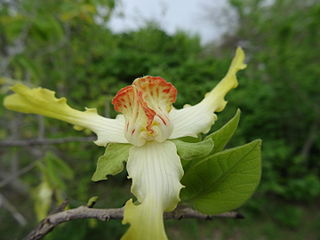
Monodora grandidieri is a species of plant in the family Annonaceae. It is native to Kenya, Malawi, Mozambique, Somalia, and Tanzania. Henri Ernest Baillon, the French botanist who first formally described the species, named it after the French naturalist and explorer Alfred Grandidier who collected the specimen Baillon examined. It has been reported to be used as a traditional medicine by the Giriama and Digo people of Kenya.
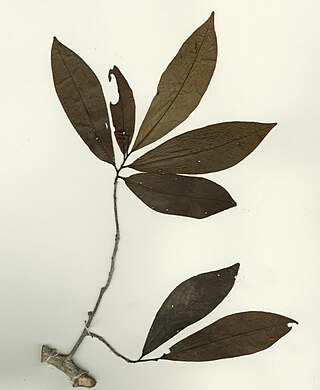
Monodora hastipetala is a species of plant in the family Annonaceae. It is native to Tanzania. Thomas Couvreur, the botanist who first formally described the species, named it after its spear shaped inner petals.
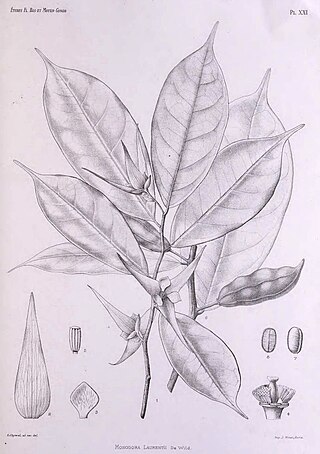
Monodora laurentii is a species of plant in the family Annonaceae. It is native to the Democratic Republic of the Congo, Gabon, and the Republic of the Congo. Émile De Wildeman, the Belgian botanist who first formally described the species, named it after Marcel Laurent, the Belgian botanist who collected many plant specimens in the regions along the Congo River.
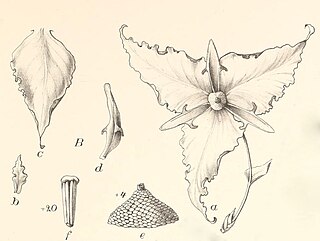
Monodora minor is a species of plant in the family Annonaceae. It is native to Mozambique and Tanzania. Heinrich Gustav Adolf Engler and Ludwig Diels, the German botanists who first formally described the species, do not explicitly explain the specific epithet but it is among the smaller members of the genus which includes species that reach heights of 30-40 meters.

Monodora stenopetala is a species of plant in the family Annonaceae. It is native to Malawi and Mozambique. Daniel Oliver, the English botanist who first formally described the species, named it after its narrow petals.

Monodora tenuifolia is a species of plant in the family Annonaceae. It is native to equatorial Africa. George Bentham, the English botanist who first formally described the species, named it after its slender leaves.
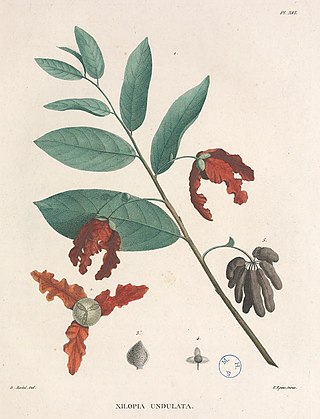
Monodora undulata is a species of plant in the family Annonaceae. It is native to Cameroon, the Central African Republic, Ghana, Guinea, Ivory Coast, Liberia, Nigeria and Sierra Leone. Palisot de Beauvois the botanist and entomologist who first formally described the species using the basionym Xylopia undulata, named it after the wavy margins of its petals.
Ophrypetalum is a genus of plant in the family Annonaceae. It is native to Kenya and Tanzania. It contains a single species, Ophrypetalum odoratum. Ludwig Diels, the German botanist who first formally described the species, named it after the perfumed odor of its flowers. Bioactive molecules isolated from its roots and leaves have been reported to have antifungal activity in tests with Candida albicans.

Mischogyne elliotiana is a species of plant in the Annonaceae family. It is native to Cameroon, Gabon, Ghana, Guinea-Bissau, Ivory Coast, Liberia, Nigeria, Sierra Leone, and Zaire. Adolf Engler and Ludwig Diels, the German botanists who first formally described the species using the basionym Uvaria elliotiana, named it after George Scott-Elliot the botanist who collected the specimen they examined.

Monodora angolensis is a species of plant in the family Annonaceae. It is native to Angola, Cameroon, Central African Republic, Democratic Republic of the Congo, Equatorial Guinea, Gabon, Ivory Coast, Nigeria, Republic of the Congo, Sudan, Tanzania, Uganda, Zambia and Zaire. Friedrich Welwitsch, the Austrian botanist who first formally described the species, named it after Angola where he found it growing near the town of Pungo-Andongo.

Neostenanthera gabonensis is a species of plant in the family Annonaceae. It is native to Cabinda Province, Cameroon, Equatorial Guinea, Gabon, Ghana, Ivory Coast, Liberia, and The Republic of the Congo. Heinrich Gustav Adolf Engler and Ludwig Diels, the German botanists who first formally described the species, using the basionym Oxymitra gabonensis, named it after Gabon where the specimen they examined was found near a site they identified as Sibange-Farm.
Pseuduvaria silvestris is a species of plant in the family Annonaceae. It is native to New Guinea. Ludwig Diels, the botanist who first formally described the species under the basionym Orophea silvestris, named it after the forested habitat the specimens he examined were found growing in near the Waria River.

Uvariastrum insculptum is a species of plant in the Annonaceae. It is native to Cameroon, Gabon, Ghana, Ivory Coast, Liberia, Nigeria, and the Republic of the Congo. Adolf Engler and Ludwig Diels, the botanists who first formally described the species using the basionym Uvaria insculpta, named it after the secondary veins on its leaves which are distinctly sunken.

Uvariastrum pierreanum is a species of plant in the Annonaceae family. It is native to Cameroon, the Central African Republic, the Democratic Republic of the Congo, Equatorial Guinea, Gabon, Ghana, Guinea, the Ivory Coast, Liberia, Nigeria, Sierra Leone and the Republic of the Congo. Adolf Engler, the botanist who first formally described the species, named it after the French botanist Jean Baptiste Louis Pierre.













